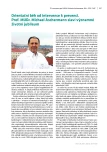Embolic ischemic strokes
Authors:
Martin Hutyra 1; Daniel Šaňák 2
Authors‘ workplace:
I. interní klinika – kardiologická LF UP a FN Olomouc, přednosta prof. MUDr. Miloš Táborský, CSc., FESC, MBA
1; Neurologická klinika LF UP a FN Olomouc, přednosta prof. MUDr. Petr Kaňovský, CSc.
2
Published in:
Vnitř Lék 2014; 60(12): 1040-1049
Category:
70. birthday prof. MUDr. Michael Aschermann, DrSc., FESC, FACC
Overview
Treatment of acute phase of ischemic stroke is aimed to limit the amount of damage using reperfusion strategy and subsequently administration of treatment providing pharmacological secondary prevention of recurrence. The early aetiology diagnosis of stroke is crucial for effective secondary prevention as the highest risk of recurrence is within few weeks after stroke. Exclusion of cardiac and vascular source of embolism by imaging methods is an important part in management of patients with ischemic stroke. These embolic sources are categorized as high risk and states are associated with moderate or unclear risk.
Key words:
acute phase of ischemic stroke – cause of ischemic stroke – reperfusion strategy – secondary prevention of recurrence – vascular and cardiac source of embolism
Sources
1. Kral M, Herzig R, Sanak D et al. Prevention of cardioemboligenic stroke in the Olomouc region of the Czech Republic. J Neurol Sci 2009; 285(Suppl 1): S160.
2. Král M, Šaňák D, Veverka T et al. Troponin T in acute ischemic stroke. Am J Cardiol 2013; 112(1): 117–121.
3. Doufekias E, Segal AZ, Kizer JR. Cardiogenic and Aortogenic Brain Embolism. J Am Coll Cardiol 2008; 51(11): 1049–1059.
4. Pepi M, Evangelista A, Nihoyannopoulos P et al. Recommendations for echocardiography use in the diagnosis and management of cardiac sources of embolism: European Association of Echocardiography (EAE) (a registered branch of the ESC. Eur J Echocardiogr 2010; 11(6): 461–464.
5. Kimura K, Minematsu K, Yamaguchi T. Atrial fibrillation as a predictive factor for severe stroke and early death in 15,831 patients with acute ischaemic stroke. J Neurol Neurosurg Psychiatry 2005; 76(5): 679–983.
6. Hylec EM, Go AS, Chang Y et al. Effect of intensity of oral anticoagulation on stroke severity and mortality in atrial fibrillation. N Engl J Med 2003; 349(11): 1019–1026.
7. O’Donnell M, Oczkowski W, Fang J et al. Preadmission antithrombotic treatment and stroke severity in patients with atrial fibrillation and acute ischaemic stroke: an observational study. Lancet Neurol 2006; 5(9): 749–754.
8. Arsava EM, Ballabio E, Benner T et al. The Causative Classification of Stroke system: an international reliability and optimization study. Neurology 2010; 75(14): 1277–1284.
9. Friberg J, Scharling H, Gadsboll N et al. Comparison of the impact of atrial fibrillation on the risk of stroke and cardiovascular death in women versus men (The Copenhagen City Heart Study). Am J Cardiol 2004; 94(7): 889–894.
10. Miyasaka Y, Barnes ME, Bailey KR et al. Mortality trends in patients diagnosed with first atrial fibrillation: a 21-year community-based study. J Am Coll Cardiol 2007; 49(9): 986–992.
11. Conen D, Chae CU, Glynn RJ et al. Risk of death and cardiovascular events in initially healthy women with new-onset atrial fibrillation. JAMA 2011; 305(20): 2080–2087.
12. Šaňák D, Herzig R, Král M et al. Is atrial fibrillation associated with poor outcome after thrombolysis? J Neurol 2010; 257(6): 999–1003.
13. Potpara TS, Polovina MM, Licina MM et al. Reliable identification of “truly low” thromboembolic risk in patients initially diagnosed with “lone” atrial fibrillation: the Belgrade atrial fibrillation study. Circ Arrhythm Electrophysiol 2012; 5(2): 319–326.
14. Potpara TS, Stankovic GR, Beleslin BD et al. A 12-year follow-up study of patients with newly diagnosed alone atrial fibrillation – implications of arrhythmia progression on prognosis: the Belgrade Atrial Fibrillation study. Chest 2012; 141(2): 339–347.
15. Stroke Risk in Atrial Fibrillation Working Group. Stroke Risk in Atrial Fibrillation Working Group. Independent predictors of stroke in patients with atrial fibrillation: a systematic review. Neurology 2007; 69(6): 546–554.
16. Camm J, Lip GYH, Atar D et al. 2012 focused update of the ESC Guidelines for the management of atrial fibrillation: an update of the 2010 ESC Guidelines for the management of atrial fibrillation. Developed with the special contribution of the European Heart Rhythm Association. Eur Heart J 2012; 33(21): 2719–2747.
17. Fuster V, Gersh BJ, Giuliani ER et al. The natural history of idiopathic dilated cardiomyopathy. Am J Cardiol 1981; 47(3): 525–531.
18. Hutyra M, Skala T, Marek D, et al. Acute severe mitral regurgitation with cardiogenic shock caused by two-step complete anterior papillary muscle rupture during acute myocardial infarction. Biomed Pap Med Fac Univ Palacky Olomouc Czech Repub 2006; 150(2): 293–297.
19. Hutyra M, Skála T, Kamínek M et al. Význam stanovení viability myokardu před revaskularizací u pacientů s ischemickou kardiomyopatií a systolickou dysfunkcí levé komory srdeční. Vnitř Lék 2008; 54(4): 395–401.
20. Meier B, Kalesan B, Mattle HP et al. Percutaneous closure of patent foramen ovale in cryptogenic embolism. N Engl J Med 2013; 368(12): 1083–1091.
21. Carroll JD, Saver JL, Thaler DE. Closure of Patent Foramen Ovale versus Medical Therapy after Cryptogenic Stroke. N Engl J Med 2013; 368(2): 1092–1100.
22. Hutyra M, Skála T, Šanák D et al. Persistent left superior vena cava connected through the left upper pulmonary vein to the left atrium: an unusual pathway for paradoxical embolization and a rare cause of recurrent transient ischaemic attack. Eur J Echocardiogr 2010; 11(9): E35. Dostupné z DOI: <<http://dx.doi.org/10.1093/ejechocard/jeq079>>.
Labels
Diabetology Endocrinology Internal medicineArticle was published in
Internal Medicine

2014 Issue 12
Most read in this issue
- Percutaneous approach for treating mitral regurgitation with mitral clip (MitraClip)
-
Anaemia and iron deficiency in clinical practice:
from cardiology to gastroenterology and beyond - Obesity and heart
- Embolic ischemic strokes
